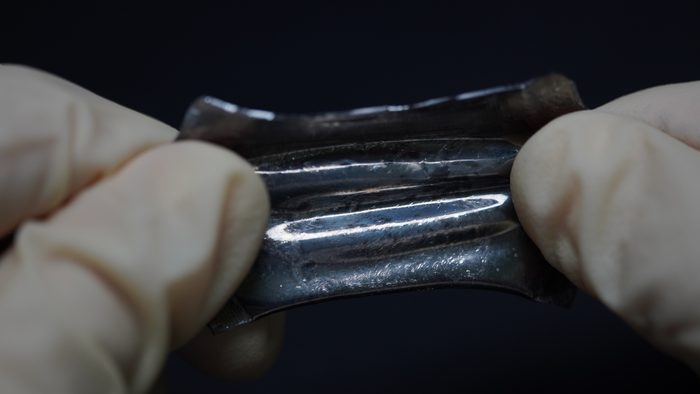Reviewed by Emily Henderson, B.Sc.Nov 1 2022
Wearable devices have earned great attention for their potential as sensors that can track several biomarkers, a source of drug delivery, medical devices, and more.
 Stretchable battery, which is packed in liquid metal, is strained by hands. Batteries can withstand stretching of more than 50%. Image Credit: Yokohama National University.
Stretchable battery, which is packed in liquid metal, is strained by hands. Batteries can withstand stretching of more than 50%. Image Credit: Yokohama National University.
Since such wearable devices must be functional and practical, they must have highly deformable and stretchable batteries. While there has been a study on enhancing the battery's flexibility while retaining battery life and other suitable properties, it is enough to give less attention to the significance of safeguarding batteries from moisture and gases.
Since wearable devices are exposed to the air, it is essential to expand battery life while safeguarding the batteries from atmospheric moisture and gases.
A research team from Yokohama National University in Japan has developed a stretchable packaging film for such batteries with a high gas and moisture barrier functionality, thereby bringing closer the chance of wearable devices with highly deformable batteries as standard technology.
Their study outcomes were reported in the journal ACS Applied Materials & Interfaces on September 27th, 2022.
Currently, the use of solid and large batteries for the stretchable device is a problem in stretchable electronics ¾ that is, while sensors and interfaces are soft, batteries still use hard batteries.
Hiroki Ota, Study Corresponding Author, Department of Mechanical Engineering, Yokohama National University
Ota added, “Soft and stretchable batteries have been studied in the world but cannot be used in the air due to the high gas and moisture permeability of the packaging materials of stretchable batteries.”
Using the layer-by-layer method, the scientists coated a thin layer of liquid metal onto a gold-deposited thermoplastic polyurethane film. This is done to make a flexible film with a high gas barrier.
This technique enabled the suitable deformability of dissimilar aluminum-laminated films, which were utilized earlier to fulfill the problem of gas and moisture permeability but missed to enable the required flexibility.
The scientists feel that the consequent film displays excellent oxygen gas impermeability under extremely low moisture permeability and mechanical strain. The stretchable lithium-ion battery that they gathered in their study was able to function accurately in the air as a result of the stretchable gas barrier film that they developed.
It is exciting that in addition to developing a stretchable battery, which could be used in the next generation of smart devices, including future wearable devices, films with high gas and moisture barrier properties can be achieved by using a novel material called liquid metal.
Hiroki Ota, Study Corresponding Author, Department of Mechanical Engineering, Yokohama National University
This study holds the assurance of utilizing batteries that possess high working voltage, high energy density, and long-term stability and are also greatly deformable—instead of bulky and inflexible—in wearable devices.
Consequently, the outcomes bring wearable devices closer to becoming highly practical, thereby opening up chances in medicine, health, and other fields.
Ota stated, “This research contributes to the social implementation of stretchable devices.”
The following steps include improving the moisture protection potential of the film by altering the materials. One more future direction is enhancing the solidity of the performance of the batteries, even under deformation, by coming up with materials that are best suited for their parts. Also, making the film affordable will add up to the ultimate scalability.
Further cost reductions of the developed film will lead to the implementation of stretchable batteries. In addition, the film could be useful as a barrier film for organic electronics.
Hiroki Ota, Study Corresponding Author, Department of Mechanical Engineering, Yokohama National University
The other authors of the study are Nyamjargal Ochirkhuyag, Yuuki Nishitai, Satoru Mizuguchi, Yuji Isano, Sijie Ni, Koki Murakami, and Masaki Shimamura, all of the Department of Mechanical Engineering at Yokohama National University; and Hiroki Iida and Kazuhide Ueno of the Department of Chemistry and Life Science at Yokohama National University.
This study was partly supported by JSPS KAKENHI, Pfizer Health Research Foundation, and JST CREST.
Journal Reference:
Ochirkhuyag, N., et al. (2022) Stretchable Gas Barrier Films Using Liquid Metal toward a Highly Deformable Battery. ACS Applied Materials Interfaces. doi.org/10.1021/acsami.2c13023.